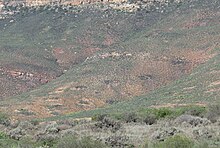Heuweltjie

Heuweltjiesare largemoundsabove or near the surface of the landscape, a type ofsoilsurface feature that occurs widely in thesouth-western Capeof South Africa. Their formation has been the subject of a wide range of speculation and of debate.
Etymology
[edit]TheAfrikaanswordheuweltjiecomes from theDutchwordheuveltje'hillock, small hill'.[1]
Description
[edit]
Heuweltjies are large mounds above or near the surface of the landscape. Like other phenomena, such asMima moundsandfairy circles,from which they have been poorly distinguished, particularly in early literature, they have been the subject of a wide range of speculation and of debate that has not yet been settled conclusively.[2][3]
Causes
[edit]
It is quite certain that not all types of heuweltjies have the same cause and nature. For one thing, the various organisms and circumstances that have been proposed to cause them do not occur throughout their range. For another, they differ in nature; some for example have been seen as improving soil fertility, an opinion documented at least as long ago as the early 20th century.[3]
Possible theories and discussions on the topic include the following:
Fossil termite mounds
[edit]One theory is that heuweltjies are fossiltermite mounds.Within this hypothesis, there are two conflicting opinions on the origins of heuweltjies, one maintaining that heuweltjies were built by the harvester termiteMicrohodotermes viator,the other that heuweltjies were built by a now possibly extinct termite species.[4]The earliestradiocarbondates on heuweltjies suggest an age of about 30,000 or even 40,000 B.P.[5]
Mole-rats and/or termites
[edit]Another theory is that heuweltjies are created by burrowing (fossorial) animals. Variants of this hypothesis are that the animals aremole-ratsin the familiesBathyergidaeandRhizomyinae;termites; or a combination of mole-rats and termites. In a review paper, Walter Whitford and Fenton Kay state that while the mounds appear to have been created by termites, mammals (aardvarks) partially maintain the mounds by feeding on and living in them. They show a (log-log) correlation between the surface area of mounds includingMima mounds,badger digs, bison wallows, mole-rat, prairie-dog and banner-tail kangaroo rat mounds, with the longevity of the disturbance ('biopedturbation', i.e. disturbance of soil by living agents including animals, roots, etc.): a heuweltjie of 100–1000 square metres is 1000–10,000 years old.[6]
Differential erosion
[edit]Yet another theory is that heuweltjies are caused by differentialerosionin places where the availability of water limits the growth of vegetation, creatingnatural patternssuch astiger bush.In favour of this theory, Michael Cramer and his colleagues note that heuweltjies contain at least ten times more soil than anytermite nestsin South Africa, and that they can occur on bedrock, which termites could not be tunnelling through to move soil upwards. Further, the heuweltjies had the same spatial distribution as bush-clumps, patches of woody vegetation forming patterns. They suggest that heuweltjies formed from bush-clumps as these protected the soil from eroding away, producing calcrete hardpans.[7]
Ecosystem theory
[edit]In 2017 Corina Tarnita and colleagues published a paper inNaturewhich explained these and other related self-organised vegetation patterns by means of a general theory which integrates scale-dependent feedbacks and the activities of subterranean ecosystem engineers such as termites, ants, and rodents.[8]
Effects
[edit]Heuweltjies modify their local environment, creating a patchwork of habitats in theNama Karooecosystem. Soils in heuweltjies are finer-grained, contain more water, and are morealkalinethan surrounding soils, and they support differing animal and plant communities. Bothaardvarkandsteenbokuse heuweltjies as dungmiddens;they are often colonised by Brant's whistling rats (Parotomys brantsii); and sheep graze and leave dung on them.[9]
See also
[edit]References
[edit]- ^"Betekenis 'hillock'".Gratis woordenboek(in Dutch). Van Dale Uitgevers. 2023.Retrieved4 April2023.
- ^C. R. Van der Merwe (1941).Soil Groups and Sub-groups of South Africa.Government Printer.
- ^abUniversity of Stellenbosch (1928).Annale - Universiteit van Stellenbosch: Reeks A.
- ^Midgley, J. J.; Harris, C.; Hesse, H.; Swift, A. Heuweltjie age and vegetation change based on13C and14C analyses. South African Journal of Science;Mar/Apr2002, Vol. 98 Issue 3/4, p202. (A study estimating heuweltjie age from calcrete from near the Clanwilliam Dam in South Africa.)
- ^Jennifer L. Horwath Burnham; Donald Lee Johnson (1 January 2012).Mima Mounds: The Case for Polygenesis and Bioturbation.Geological Society of America. pp. 70–.ISBN978-0-8137-2490-4.
- ^Whitford, Walter G.; Kay, Fenton R. (1999)."Biopedturbation by mammals in deserts: a review"(PDF).Journal of Arid Environments.41(2): 203–330.Bibcode:1999JArEn..41..203W.doi:10.1006/jare.1998.0482.Archived fromthe original(PDF)on 27 May 2014.
- ^Cramer, Michael D.; Innes, Sheona N.; Midgley, Jeremy J. (2012)."Hard evidence that heuweltjie earth mounds are relictual features produced by differential erosion".Palaeogeography, Palaeoclimatology, Palaeoecology.350–352: 189–197.Bibcode:2012PPP...350..189C.doi:10.1016/j.palaeo.2012.06.030.
- ^Tarnita, Corina E.; Bonachela, Juan A.; Sheffer, Efrat; Guyton, Jennifer A.; Coverdale, Tyler C.; Long, Ryan A.; Pringle, Robert M. (2017)."A theoretical foundation for multi-scale regular vegetation patterns"(PDF).Nature.541(7637): 398–401.Bibcode:2017Natur.541..398T.doi:10.1038/nature20801.PMID28102267.S2CID205252942.
- ^Seymour, Colleen."Deserts and Xeric Shrublands: Nama Karoo".World Wildlife Fund (WWF).Retrieved26 May2014.Page has extensive bibliography.
